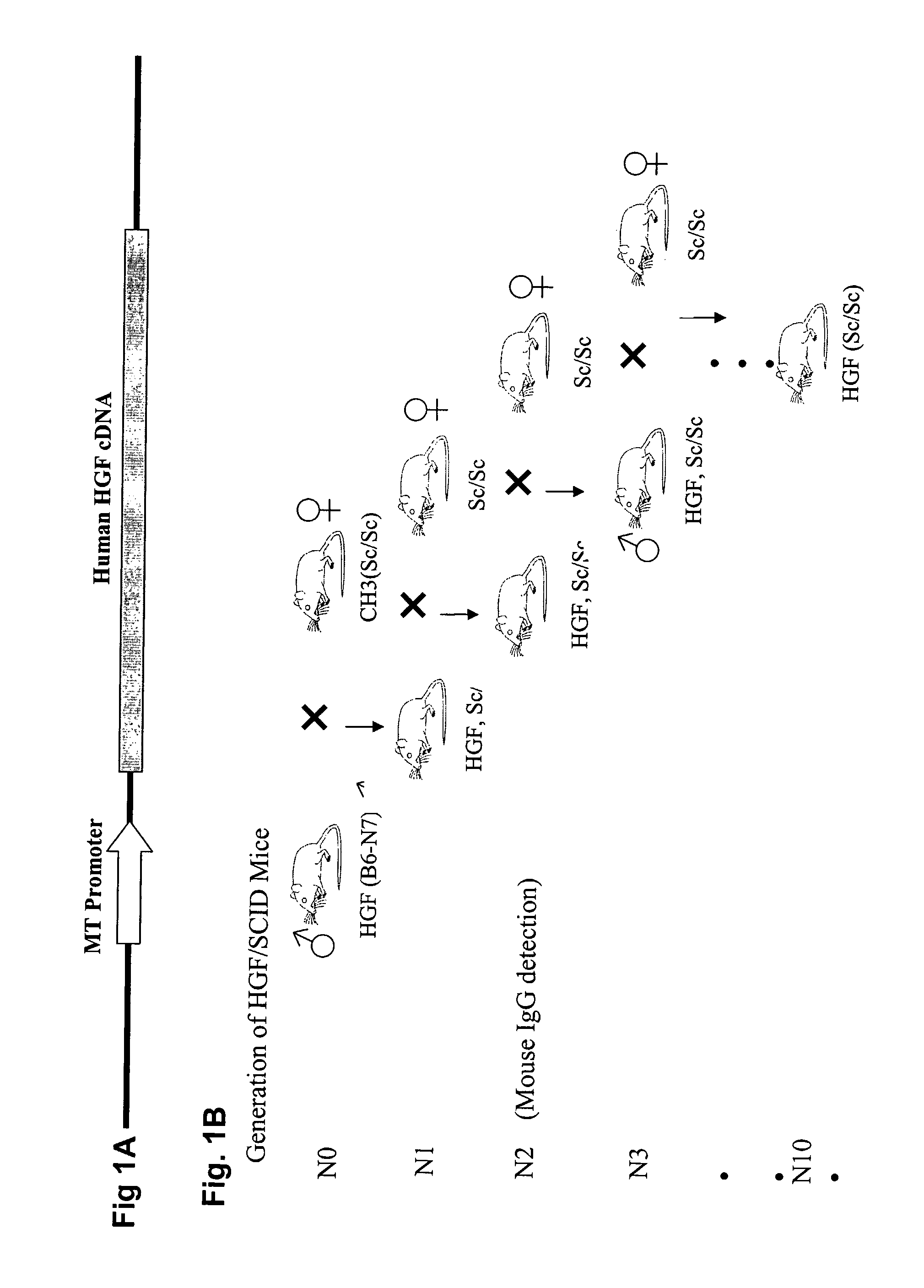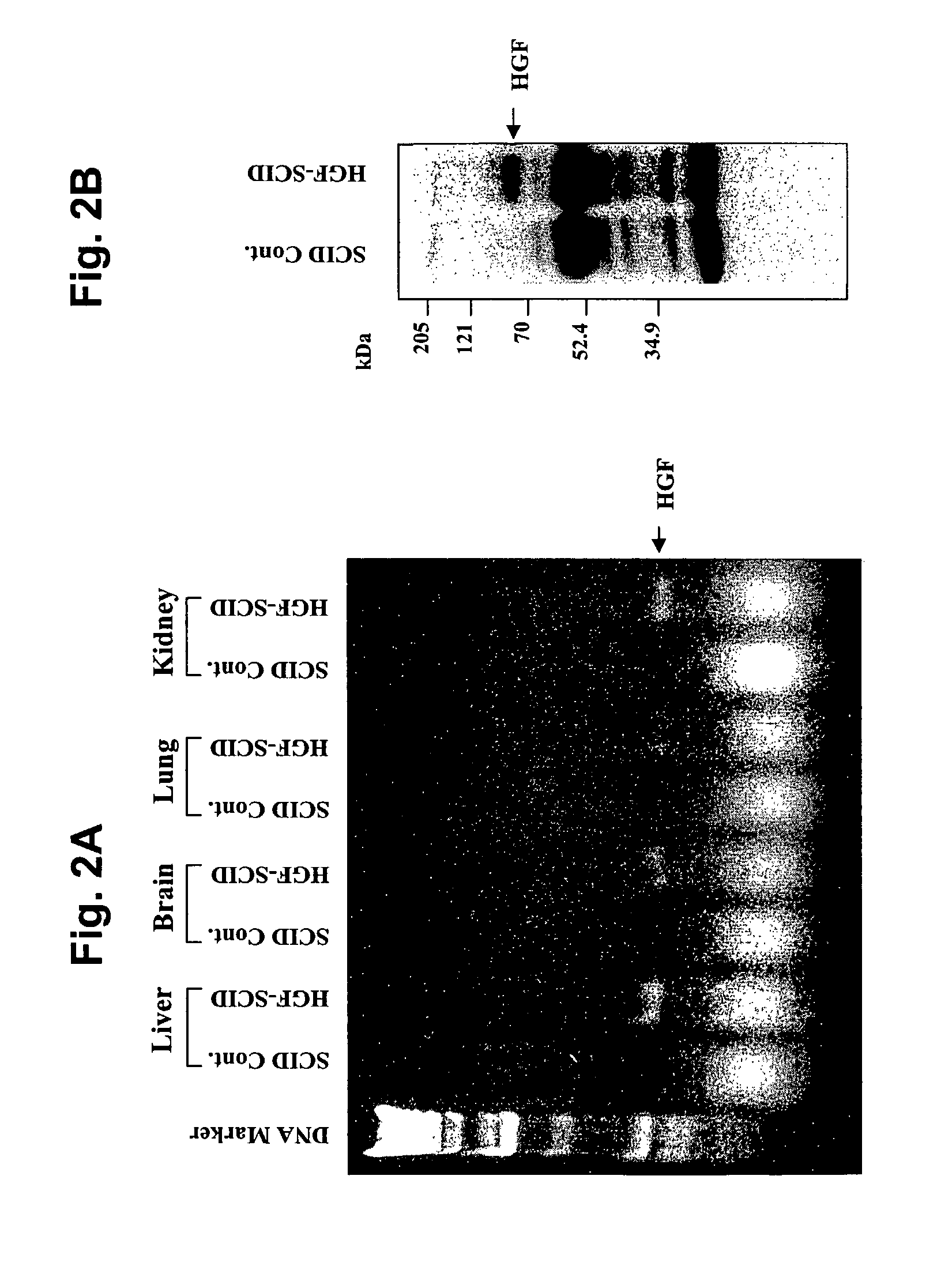Immune-compromised transgenic mice expressing human hepatocyte growth factor (hHGF)
a technology of transgenic mice, which is applied in the field of immunocompromised transgenic mice expressing human hepatocyte growth factor (hhgf), can solve the problems of poor prognosis, poor cell selection, and less than satisfactory known animal “systems”
- Summary
- Abstract
- Description
- Claims
- Application Information
AI Technical Summary
Benefits of technology
Problems solved by technology
Method used
Image
Examples
example i
Materials and Methods
Cell Lines and Tumors
[0154]The following cell and tumor lines were used: S-114 are NIH-3T3 murine cells transformed with hHGF hMet (Rong S et al. (1993) Cell Growth Differ 4:563-69) and M-114 are NIH-3T3 murine cells transformed with murine HGF (“mHGF”) and murine Met (“mMet”). The above two lines were grown in DMEM supplemented with 8% calf serum (v / v). SK-LMS-1 is a human leiomyosarcoma cell line in which hMet and hHGF function in an autocrine manner (Jeffers et al. (supra). These cells were maintained in DMEM supplemented with 10% fetal bovine serum (v / v). DA3 is a mouse mammary carcinoma cell line expressing mMet (Firon M et al. (2000) Oncogene 19:2386-97); these cells were grown in DMEM supplemented with 10% fetal bovine serum (v / v) and antibiotics. 121-1TH-14 cells are NIH-3T3 murine cells transformed with hMet. Okajima cells are human gastric carcinoma cells expressing Met (Faletto D L et al. (1993) Experientia Suppl. 65:107-30). Parental DBTRG-05MG (DB-P...
example ii
Production of hHGF / SF Tg scid Mice
[0173]The production of hHGF Tg scid mice is schematically represented in FIG. 1B. To create Tg mice expressing hHGF ligand, an expression vector carrying hHGF cDNA driven by the mouse metallothionein-1 (MT) gene promoter (FIG. 1A) was microinjected into C3H / B6 mouse embryos. Presence of the hHGF transgene in mice was determined by PCR-based genotyping using primers specific for the transgene. The derived hHGF-Tg mice were then crossed onto mice homozygous for the scid mutation, the presence of which was determined by the absence of mouse IgG. hHGF Tg mice with scid backgrounds were obtained by backcrossing the Tg mice produced as above to C3H scid / scid homozygotes for ten generations to obtain mice congenic for hHGF on the C3H scid background (FIG. 1B). One characteristic phenotypic trait present in all hHGF Tg scid mice was a black tail (from the B6 progenitor), which is easily distinguished from the brown tails of the C3H scid mice that did not p...
example iii
Expression of hHGF / SF in Tg scid Mice
[0174]To determine whether the hHGF transgene was expressed, RNA samples were prepared from different tissues of both “control” scid mice and hHGF Tg scid mice. By RT-PCR analysis using primers specific for hHGF, it was determined that hHGF transcripts were expressed in a wild range of tissues including liver, brain, lung and kidney (FIG. 2A). The presence of the hHGF protein was also confirmed in livers of the hHGF Tg scid mice by immunoprecipitation and Western Blot analysis using antibodies against hHGF (FIG. 2B). A significant amount of hHGF ligand was also detected in the circulating blood of the hHGF Tg scid mice as determined by sandwich ELISA using the same antibodies (Table 1 / FIG. 3). Thus, the hHGF ligand is expressed in the hHGF Tg scid mice.
[0175]
TABLE 1SCID Control MiceHGF / SCID MiceMouseSerum HGFMouseSerum HGFNo.(ng / ml)No.(ng / ml)1011.452023.243030.434041.355050.3160.1661.167070.74
PUM
| Property | Measurement | Unit |
|---|---|---|
| pH | aaaaa | aaaaa |
| pH | aaaaa | aaaaa |
| pH | aaaaa | aaaaa |
Abstract
Description
Claims
Application Information
 Login to View More
Login to View More - R&D
- Intellectual Property
- Life Sciences
- Materials
- Tech Scout
- Unparalleled Data Quality
- Higher Quality Content
- 60% Fewer Hallucinations
Browse by: Latest US Patents, China's latest patents, Technical Efficacy Thesaurus, Application Domain, Technology Topic, Popular Technical Reports.
© 2025 PatSnap. All rights reserved.Legal|Privacy policy|Modern Slavery Act Transparency Statement|Sitemap|About US| Contact US: help@patsnap.com



